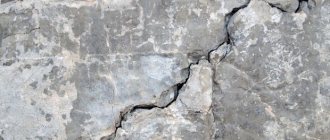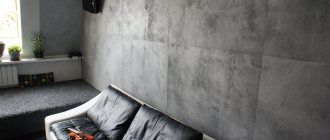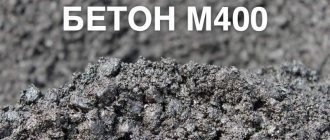Concrete mixtures occupy a central place in construction. In terms of the amount of building material involved, concrete occupies the main position, and in terms of the cost of the finished structure it can exceed the costs of all building materials combined.
This situation especially applies to large-sized and specialized buildings, where replacing concrete is impractical. During the construction of special structures, concrete with improved characteristics is used. One of these types is high-strength concrete. It complies with GOST 31914-2012 [2]. The compressive strength of this building material corresponds to class B60 or higher. The binder base is Portland cement clinker.
Table 1 – Areas of application of high-strength concrete
| Application area | Building/structure |
| Civil Engineering | High rise buildings |
| Monolithic structures | Road slabs, floor slabs, vaults |
| Prefabricated monolithic structures | Platforms, tunnels |
| Military facilities | Bunkers, buildings at landfills |
| Spaceports | Launch pads |
High-strength concrete is intended for buildings with a high level of load, so the requirements for its quality are very high.
Composition of high-strength concrete
The main components by volume are cement, water, aggregates. But additives also have a great influence on the properties of concrete. The combined action of all components affects the final result, so the characteristics and proportions of each component are important: they will affect the quality of concrete and the possibilities of its use.
Cement
It heads the list of materials, because the class of concrete will depend on the grade of cement. To prepare high-strength concrete, varieties of Portland cement are used, including cements with mineral additives that have a steaming activity of 32 MPa or more. This reduces the duration of heat and humidity treatment and reduces its cost.
To save money, it is permissible to reduce the amount of cement, but use additives that increase strength. To increase the service life of the structure, cement is used with a normal density of no more than 30%. The temperature of the cement should not exceed 60 °C.
Water
The content of sugars, organic surfactants and phenols in quantities of more than 10 mg/l is not allowed in water. The presence of oils, petroleum products, fats, coloring impurities, as well as impurities that violate the properties of concrete (adhesion, frost resistance) is not allowed.
The use of industrial water and water from natural sources is allowed, but the impurity content must comply with the requirements of the standards.
Fillers
Fine aggregate
As with most concretes, these are coarse or fine sands of natural origin or from screenings of crushed rocks from the mining industry. The grain density can vary from 2000 g/cm³ to 2800 g/cm³. It is acceptable to use sand from the slags of non-ferrous and ferrous metallurgy, as well as ash and slag mixtures. Density, composition (concentration of dust particles and clayey particles), sand voids are taken into account. Poor quality or dirty sand significantly reduces the properties of concrete.
Coarse aggregate
Coarse fractional aggregate – crushed stone, the strength of which must be higher than the required grade of concrete; crushed stone extracted from rocks with high strength (diabase, granite, etc.).
The content of low-strength grains should not be more than 10% by weight. Frost resistance of crushed stone and strength (from 100 MPa) are taken into account. If there are plasticizers in the mixture, a crushed stone strength of 80 MPa is allowed. The final suitability of the aggregate is determined only after testing the concrete.
- For concrete, it is not recommended to use rock with a smooth surface as coarse aggregate.
- The grain density should vary from 2000 to 3000 kg/m³.
- In the composition of crushed stone, the presence of dust and small particles of clay is allowed no more than 2% by weight.
The grade of crushed stone affects the final grade of concrete, so the grade of crushed stone should be higher than that of concrete. So, for concrete class B45, the grade of crushed stone must correspond to class 1200.
Supplements
Additives for concrete in construction perform several functions. The main thing is to strengthen the necessary properties of concrete (resistance to very low temperatures and temperature changes; resistance to strong vibrations; water resistance, etc.). To increase the cost-effectiveness of construction, the supporting properties of concrete are enhanced while the amount of metal structures and aggregates is reduced. You can lighten the overall weight of the structure by adding chemical components while maintaining strength.
Since high-strength concrete is subject to increased requirements, plasticizer additives are required in the composition. If Portland cements with mineral additives are used, the amount of chemical additives increases by 15%.
Purpose of using plasticizing additives:
- reduce water consumption in concrete while maintaining its strength;
- optimize the amount of cement while maintaining the workability and strength of concrete;
- increase construction savings and improve technical characteristics of concrete (resistance to cracking, shrinkage, etc.);
- increase the mobility of mixtures, reduce the installation time when working with structures of complex configurations.
When using additives, one must focus on the compatibility of the additives used and their effect on the properties of concrete.
Concrete with frost resistance requirements of F200 and higher, as well as concrete for hydraulic structures, should be made using gas-forming or air-entraining additives.
Concrete for use on road and airfield pavements must contain air-entraining additives and plasticizers.
Concrete grades P4 and P5 for workability are prepared with the mandatory content of plasticizers for monolithic and prefabricated structures.
Features of modern concrete compositions
Even in Soviet times, the standard range of building materials provided for the possibility of producing high-strength concrete of the corresponding classes from B40 to B60 . They were used in the construction of especially critical structures and elements of bridges, dams, railway sleepers and others. However, the distinctive characteristic of these compositions was their high rigidity and low ability for high-quality installation.
Modern composite mixtures of increased strength are distinguished not only by high resistance to mechanical and weight loads, but also by an excellent level of manufacturability when laid in a monolithic structure. Very good mobility and the ability of materials to self-compact make it possible to eliminate the use of vibration equipment and reduce the required number of workers on the construction site.
The ability of heavy-duty concrete to self-compact during placement
When producing new types of concrete, manufacturers of building materials obtain a unique structure of artificial stone thanks to the use of continuous granulometry technology for all constituent components.
Precisely selected fractions of fillers no larger than 20 mm in size and specially processed to obtain a special shape make it possible to obtain a special active structure of the material, capable of flowing and compacting under its own weight. Due to these properties, such mixtures received the general name of self-compacting concrete (SCC).
Rules for selecting a composition for high-strength concrete
Selecting the composition of the mixture is a critical stage during construction, especially with the use of high-strength concrete. The selection is made in compliance with all technical conditions in stages:
- assessment of the quality of mixture components;
- determining the required quality level of the concrete mixture;
- calculation of the number of concrete components for preliminary tests and production of samples;
- testing of control samples;
- making changes to the calculation of the composition of components and the use of a new composition in production conditions.
The presence of unique properties in high-strength concrete is achieved by complicating some production technologies. Thus, to achieve increased strength, the amount of water is reduced: at a rate of 0.4 in high-strength mixtures it is less than 0.35. The cement content has been increased to 600 kg/m³. The water requirement of such mixtures is increased, the sand concentration is reduced, etc. All these indicators must be taken into account, depending on the desired grade of concrete at the output.
For the general case, the composition and amount of materials for samples can be calculated as follows:
- Determine the amount of water based on general data on the properties of fine and coarse aggregates.
- Determine the amount of plasticizing additives (0.2-0.4% for superplasticizers; 0.05-0.1% for plasticizers).
- The amount of water in the mixture can be reduced by using additives.
- Take three values and, with the specified amount of mixing water, calculate the corresponding cement consumption. It is recommended to take values of 2.5...3.5. When air-entraining additives are added, the strength of concrete decreases.
- Calculate the proportions of sand and crushed stone, focusing on their indicators and the desired result.
After all the necessary calculations have been carried out, prototypes should be prepared. Based on the finished samples, the obtained properties are analyzed, the consumption per 1 m³ is calculated and, if necessary, adjustments are made to the composition.
Concrete class
(B) is an indicator of the compressive strength of concrete with a probability of 95%, measured in MPa. Defined by values from 0.5 to 120 MPa. That is, what is the maximum pressure that concrete will withstand in 95 cases out of 100 (B50 = 50 MPa).
Concrete grade
In addition to strength indicators, there is a grade (M) of concrete - marking the compressive strength, measured in kgf/cm². And if the concrete class guarantees the quality of concrete in terms of strength by 95%, then the brand determines the average strength value.
Table 2 shows the correspondence of classes and grades for high-strength concrete.
Table 2 - Correspondence of strength classes and grades of high-strength concrete
| Concrete strength class | The closest concrete grade in terms of strength |
| B60 | M800 |
| B65 | M900 |
| B70 | M900 |
| B75 | M1000 |
| B80 | M1000 |
Advantages of concrete: how is it different from regular concrete?
Quite complex structures made from this material will not be overly heavy.
The world's strongest concrete can be the solution to a complex architectural design. Concrete material is easily reinforced with reinforcing materials. The use of high-strength mixtures in the construction of reinforced concrete structures, which are based on heavy concrete grades M-400 and 500, is especially popular. The use of building materials can significantly reduce the weight of the object under construction, reduce the cross-sectional diameter of the structure, and quickly and effectively give ideal parameters to the intended product.
Characteristics of high-strength concrete
A number of features that distinguish heavy concrete from light concrete:
- high specific strength;
- increased density;
- durability, high strength, hardness and frost resistance;
- increased production costs;
- high thermal conductivity.
The use of one or another type of concrete is regulated by the requirements for finished structures.
Under the influence of weather conditions that will affect the operation of structures, the grade of frost-resistant concrete is determined. If the air temperature can drop to –40 °C, then frost resistance concrete should be used at least F75. Based on the operation of the finished structure and the conditions of its location, it is necessary to accurately determine the type of concrete for construction. For convenience of the work process and savings, you can use concrete of different grades on one construction site.
Prices for high-strength concrete
Approximate prices for concrete class B45 and higher are given in table. 3.
Table 3 - Prices for high-strength concrete
| Class (brand) of concrete | Price |
| B45 (M600) | 4400 RUR/m3 |
| B50 (M700) | 4500 RUR/m3 |
| B60 (M800) | 4680 RUR/m3 |
| B80 (M1000) | 5100 rub./m3 |
The prices shown in Table 3 are approximate and current at the time of studying the article (4th quarter of 2022). To obtain more accurate information, you should check prices with the supplier.
Types of high-strength concrete
High-strength concrete, depending on the composition, purpose and main characteristics, is divided into several types.
Fine concrete
The main property is the absence of coarse fractional filler. This type of concrete is preferred in places where it is not possible to use crushed stone or gravel. Due to the absence of large fractions, fine-grained concrete acquires new properties: the density of the building material increases, and cement is used no less than grade M500. If necessary, take cement with special conditions: resistance to corrosion, resistance to acids, etc.
pros:
- excellent water resistance;
- no filler;
- resistance to bending moment;
- the ability to obtain unique properties (using additives);
- vibration resistance;
- homogeneity of the mixture (allows use when working with complex elements);
- excellent ductility and penetrating ability.
Minuses:
- increased cement content (and therefore slightly increased its creep and shrinkage);
- difficult processing after complete hardening;
- noticeable shrinkage after full strength gain.
Since there is no filler, cement consumption increases; consumption can be compensated by using plasticizing additives and high-quality sands.
Application . Such concrete is used in the manufacture of thin-walled products, in particular reinforced cement. There are 5 main grades of concrete in use, each of which has its own purpose:
- M 100 – for repair work;
- M 200 – for structures that do not require large loads;
- M 300 – for filling forms with frequent reinforcement;
- M 350 and M 400 – for casting critical structures.
The class of fine-grained concrete reflects its resistance to compression; for this type it reaches a value of B80.
Dispersed reinforced concrete
The peculiarity of this type is the content of reinforcing fibers (fibres). Fibers can be: steel, mineral (for example, glass), organic (for example, bamboo). It is made on the basis of Portland cement grade no lower than 400, without mineral additives. The composition also includes sand of natural origin or artificial.
Application . Mainly for road construction: pavement of streets, highways, sidewalks, local roads, blind areas, etc.
Prestressing concrete
The main property of prestressing concrete is self-tension. Created by expanding the mixture during hardening. During the initial period of hardening, concrete expands and stretches the reinforcement in adhesion to it. It is made from tensile cement, which is based on high-aluminate slag (usually metallurgy waste), coarse and fine aggregates (usually crushed stone and sand).
Characteristic:
- increased resistance to cracking;
- waterproof;
- durability.
- strength gain at t = 30 °C and above.
Application . The characteristics of concrete make it possible to use it in capacitive monolithic and prefabricated structures for various purposes, as well as for the manufacture of: pressure and free-pressure pipes, tunnels, airfield pavements, bridges, etc. Self-stressing properties are well demonstrated for sealing and protection from sources of radiation.
Basalt fiber reinforced concrete
It is obtained by introducing pieces of basalt fiber into the concrete mixture. Basalt fiber is characterized by very high strength, lack of deformation and elasticity, exceeding concrete by 3 times or more. The fiber density is 3 times less than steel, which makes the finished structure lighter. The binding component is Portland cement.
pros:
- high strength and resistance to deformation;
- lower weight of the finished building structure than using other fillers;
- better adhesion of the fiber surface to the cement matrix compared to the properties of other concretes;
- the concrete mixture is homogenized.
Minuses:
- economically expensive, because the cost of concrete increases with the use of basalt fibers;
- the use of Portland cement and calcium hydroxide in concrete can lead to destruction or deterioration of the properties of basalt fibers.
To reduce the destructive effect of the constituent components of the cement mixture, additives are used.
Sand concrete
Its main difference from most types of concrete is that it is based only on fine aggregate, which helps reduce the cost and time for its production. And also low labor intensity during production.
Characteristics of sand concrete:
- high hardening speed;
- laying without vibrating tools;
- corrosion resistance;
- great strength;
- waterproof;
- less shrinkage;
- frost resistance (when using additives);
- Fire safety;
- non-toxic to humans.
Application . It is actively used in the construction of roads of any load level and in airfield construction. In civil engineering - when pouring floors, brickwork, concrete screed; during emergency and rescue operations. High-strength concrete of class B90 is used in industrial production and in the manufacture of reinforced concrete products.
Where used: material application
Bridges can be built using a material with this property.
A mortar with high durability and resistance to destructive factors is indicated for use in all areas of construction. Application of high-strength concrete:
- construction of reinforced concrete structures;
- for road surfaces;
- construction of bridges and airfield runways;
- for the construction of warehouses with specific operational features;
- pouring floors inside large-scale industrial and residential buildings.
Production of high-strength concrete
Making high-strength concrete is a costly task both in terms of labor and finances. Since this type of building material is used for specialized buildings, its use at home is not practical. The need to purchase expensive materials, such as especially strong cement, low W/C ratio, and the use of superplasticizers, makes the process of producing such concrete energy-intensive and expensive.
Information sources:
- GOST 7473-2010
- GOST 31914-2012
- SNiP 52-01-2003
- SP 311.1325800.2017
- GOST 26633-91
- Recommendations on the technology of manufacturing products and structures from high-strength concrete (approved 04/04/1986)
- Construction materials and products. Textbook – Barabanshchikov Yu. G., 2008. – 368 p.
- EN 12350-5:2000 Testing of concrete mixtures - Part 5: flow test.
- EN 12350-4:2000 Testing of concrete mixtures - Part 4: degree of compactability.
Application of highly durable concrete
Concrete composite mixtures of the new generation differ from classic brands in higher cost. Therefore, their use should be based on technical and economic calculations. Such high strength indicators are not required in mass standard construction, and therefore the question of using these materials does not arise often.
Most often, high-strength concrete is used in the construction of high-rise buildings, bridges, hydraulic structures, power plants and structures of complex geometric shapes. Not so long ago, high-rise buildings were erected from metal, since reinforced concrete structures were unable to withstand the weight of several dozen floors. Modern composite materials can significantly reduce the metal consumption of building structures and provide the necessary strength and reliability.
Ponte Sheikh Zayed
It is used for the construction of long bridge spans, reducing the number of load-bearing supports and speeding up the project completion time. The use of new composite materials is usually aimed at solving complex engineering problems and is rarely found in traditional construction methods.











